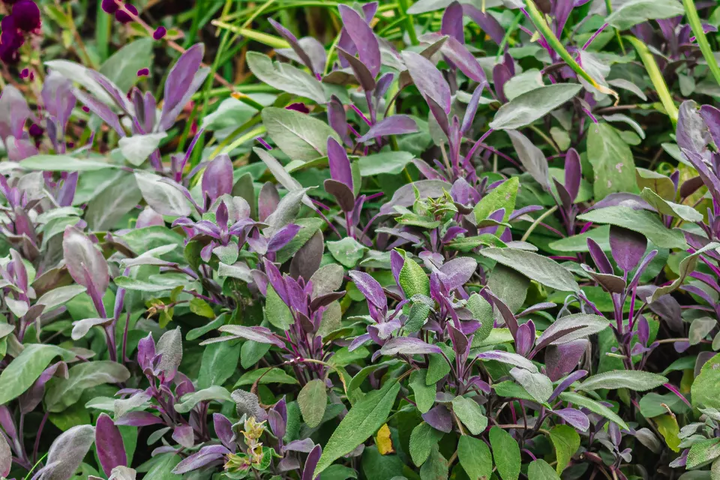Salvia is the largest genus of the Mint (Lamiaceae) family. There are nearly 1,000 species in this genus, and Purple Sage (Salvia dorrii) is just one of those.
Also referred to as Desert Sage, this woody, upright, perennial shrub makes the perfect addition to xeriscape landscapes and desert-style rock gardens where other plants struggle to survive. They're also a good choice for hot regions that have water conservation restrictions. In the right conditions, this species is hardy, easy-to-grow, drought-tolerant and low-maintenance. They do, however, need excellent drainage and hot and dry conditions to thrive.
The showy deep blue flowers of this plant bloom in late spring and remain through much of the summer. They're magnets for pollinators, and your garden can become a butterfly lovers paradise.
The purple bracts and semi-evergreen gray foliage also add a further splash of color throughout the year (although you should expect some leaf drop in colder winter conditions). The highly aromatic leaves that have mild hallucinogenic properties have traditionally been used by Native Americans in herbal medicine and for tribal ceremonies.
It's worth noting that it isn't just Salvia dorrii that is referred to as Purple Sage, and this can sometimes cause confusion and misidentification. Some of the other species that use this name include San Luis Sage (Salvia leucophylla), Giant-Flowered Purple Sage (Salvia pachyphylla), Frosted Sage (Poliomintha incana), and Texas Sage (Leucophyllum frutescens).
Botanical Name:
Salvia dorrii
Common Name:
Purple Sage, Tobacco Sage, Dorr's Sage, Desert Sage
Plant Type:
Herbaceous perennial shrub
Mature Size:
Up to 3 foot tall
Sun Exposure:
Full sun
Soil Type:
Prefers a sandy, well-drained soil
Soil pH:
6 to 8
Bloom Time:
Late spring into summer
Flower Color:
Purple and blue
Hardiness Zones:
6 to 10
Native Area:
Western United States

How to Grow Purple Sage Bush
Purple Sage thrives in desert conditions. If you live in a region with high humidity, rich soils and plenty of rain, this isn't going to be the plant for you.
It's a perfect choice, however, if you're located somewhere hot, sunny and arid, where other flowering plants struggle to survive. You don't need to worry if your soil is nutrient-poor either - Purple Sage loves this!
Light
Purple Sage is a true sun-lover. You should select a spot where they get plenty of direct sunlight. South-facing slopes are a perfect choice.
The only exception will be if you live in a region that experiences particularly intense desert conditions. In these instances, they may appreciate some afternoon shade.
If your Purple Sage doesn't get enough sun, they won't produce such impressive blooms, and they can be more prone to scale or problems with aphids or mealybugs.
Soil
Purple Sage suits areas with poor quality, infertile soil. They don't appreciate rich, acidic or irrigated conditions. In fact, they often do better growing from a mound of sand or gravel if the soil in your garden is slightly richer.
If you don't have a fast-drying, well-draining soil, it would be better to plant your Purple Sage in containers to ensure they get the drainage they need.
Water
Once your Purple Sage is established, they need little to no watering - even in the summer months.
They're an incredibly drought-tolerant species, and this is what makes them such a perfect choice for desert-gardens where very few other flowering plant species can survive.
Overwatering can shorten the life expectancy of your Purple Sage. The plant will be less healthy, and it can suffer from root rot.
Temperature and Humidity
Purple Sage thrives in inhospitably hot and dry conditions. It isn't going to be suited to gardens with mild summer temperatures or high humidity.
Fertilizer
Because this plant enjoys dry, infertile conditions, they don't need a lot of nutrients.
It's best to steer clear of fertilizers as this can shorten the life of your Purple Sage.
Propagating Purple Sage Bush
Purple Sage can be propagated from established semi-hardwood cuttings at any time of year. Best results are usually seen if they're taken in the latter part of the year and started off in a greenhouse. The established cuttings can then be transplanted out to their permanent site in spring.
It's also possible to divide existing plants.
Pruning
Purple Sage sees new branches growing every season, although most of these die back in the winter. This means that pruning isn't necessary.
Light pruning, however, particularly of the outer branches, can help the plant to maintain an upright form and encourage healthy growth.
When the bracts are starting to fade, removing the heads of the flowers can also help the plant to look a little neater.
Being Grown in Containers
If you're concerned about your soil being overly fertile, acidic or not fast-draining, then it would be better to grow your Purple Sage in containers.
Make sure the potting medium you select is incredibly fast draining and that the pots have decent-sized drainage holes too.
Growing From Seeds
With the right conditions, Purple Sage can establish quickly from seeds. To increase the chance of success, they should go through a period of cold stratification and be kept consistently moist until they germinate.